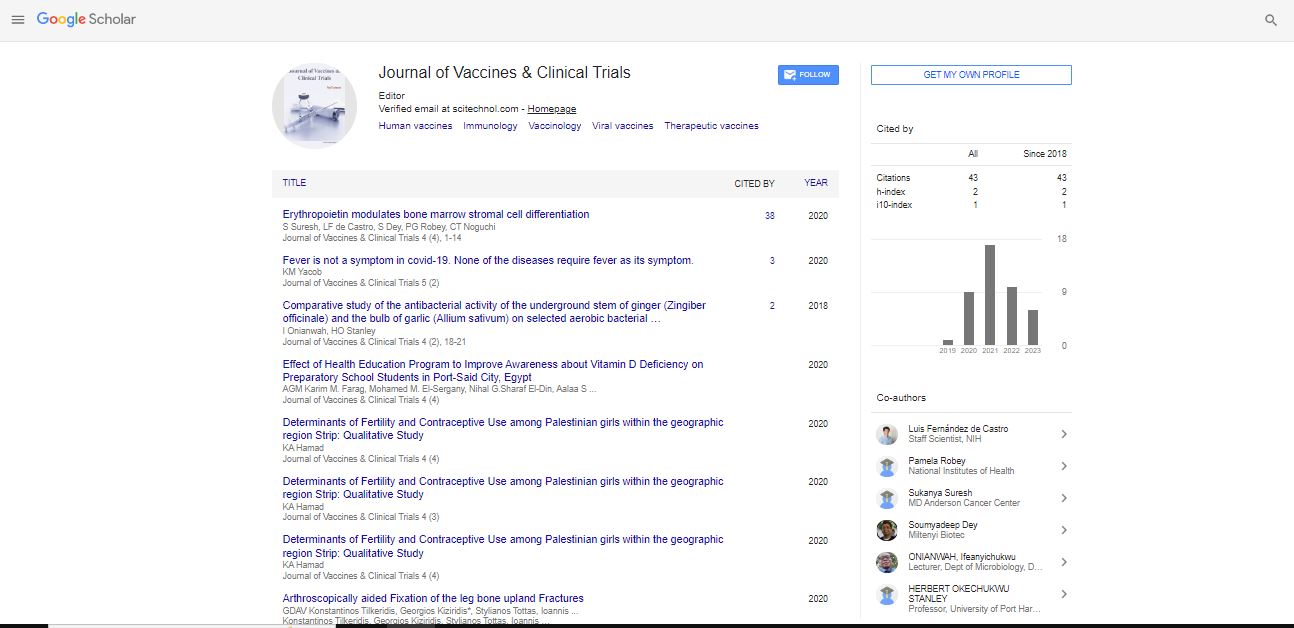Commentary, Jou Of Vac Cli Tr Vol: 7 Issue: 4
An Overview on Infectious Diseases: Its Global Impact and Challenges
Muhammad Parker*
1Department of Population Health and Disease Prevention, University of California, California, USA
*Corresponding Author: Muhammad Parker,
Department of Population Health
and Disease Prevention, University of California, California, USA
E-mail: parkerparker@uci.edu
Received date: 27 November, 2023, Manuscript No. JVCT-24-128358;
Editor assigned date: 30 November, 2023, Pre QC No. JVCT-24-128358 (PQ);
Reviewed date: 07 December, 2023, QC No. JVCT-24-128358;
Revised date: 21 December, 2023, Manuscript No. JVCT-24-128358 (R);
Published date: 28 December, 2023 DOI: 10.4172/JVCT.100088
Citation: Parker M (2023) An Overview on Infectious Diseases: Its Global Impact and Challenges. Jou of Vac Cli Tr 7:4.
Description
Infectious diseases have been an enduring challenge throughout human history. These illnesses are caused by pathogenic microorganisms such as bacteria, viruses, fungi, parasites, and prions. They can be transmitted from one individual to another, leading to a wide array of symptoms, severity, and impacts on communities and societies. Understanding these diseases involves delving into their modes of transmission, their impact on global health, the mechanisms of their spread, and the strategies used to prevent, control, and treat them.
Microorganisms responsible for infectious diseases are diverse and can affect different parts of the body. Viruses, being among the smallest infectious agents, invade host cells and hijack their machinery to reproduce. Notable viral diseases include influenza, HIV/AIDS, COVID-19, and hepatitis.
Bacteria, single-celled organisms, can cause infections ranging from minor ailments like strep throat to life-threatening conditions such as tuberculosis and bacterial meningitis.
Fungi, like Candida or Aspergillus species, cause fungal infections. They can affect the skin, lungs, or even internal organs in immunocompromised individuals.
Parasites, such as Plasmodium causing malaria or helminths causing diseases like schistosomiasis, thrive by living on or inside their hosts, causing a range of health problems.
Prions, abnormal proteins, cause rare but fatal conditions like Creutzfeldt-Jakob disease, leading to brain damage and neurological symptoms.
Understanding how infectious agents spread is crucial in preventing outbreaks. These microorganisms can be transmitted through various routes. Direct transmission occurs through physical contact between infected and susceptible individuals, such as through droplets (coughing, sneezing) or bodily fluids.
Indirect transmission occurs when pathogens are transmitted via contaminated surfaces or objects (fomites), through vectors like mosquitoes or ticks (vector-borne diseases), or through the air (airborne transmission), remaining suspended and infecting individuals in proximity.
Foodborne and waterborne transmission occur through contaminated food or water sources, leading to illnesses like cholera, salmonella infections, or parasitic infestations.
Infectious diseases pose significant global health challenges, impacting economies, healthcare systems, and societies worldwide. They disproportionately affect developing countries due to factors like inadequate healthcare infrastructure, poor sanitation, and limited access to vaccines and treatments.
Outbreaks of infectious diseases can lead to public health emergencies, strain healthcare resources, and cause substantial morbidity and mortality. The ongoing battle against infectious diseases also faces challenges due to antimicrobial resistance, where microorganisms evolve to resist the effects of medications, making infections harder to treat.
Effective prevention and control strategies are crucial in managing infectious diseases. Vaccination remains one of the most successful public health interventions, preventing numerous infectious diseases and reducing their spread. Promotion of hygiene practices such as hand washing, sanitation improvements, and proper food handling also plays a pivotal role in preventing infections.
Surveillance and early detection are vital in containing outbreaks. Timely identification, isolation, and treatment of infected individuals help prevent further transmission. Public health measures like quarantine, travel restrictions, and social distancing have been employed during pandemics to curb the spread of diseases.
Antimicrobial stewardship programs aim to ensure the prudent use of antibiotics and other antimicrobial drugs to slow down the development of antimicrobial resistance.
While significant progress has been made in controlling many infectious diseases through vaccination, improved sanitation, and advanced medical treatments, challenges persist. Emerging infectious diseases continue to pose threats, as seen with the outbreak of novel viruses like SARS-CoV-2, highlighting the need for robust preparedness and response systems.
Climate change, urbanization, globalization, and increased antimicrobial resistance present ongoing challenges in the battle against infectious diseases. Addressing these challenges requires a multifaceted approach, including collaborative efforts among governments, healthcare systems, researchers, and communities.
 Spanish
Spanish  Chinese
Chinese  Russian
Russian  German
German  French
French  Japanese
Japanese  Portuguese
Portuguese  Hindi
Hindi 